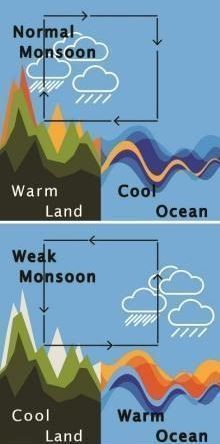At a time when drought is looming over India, a new study brings in more grim news on the monsoon rains crucial for the country's economy.The study led by Roxy Mathew Koll at the Indian Institute of Tropical Meteorology (IITM) in Pune says rapid warming in the Indian Ocean is playing an important role in weakening the monsoon circulation and rainfall1.
Using long-term observations and climate model experiments, the authors provide “compelling evidence that the enhanced Indian Ocean warming potentially weakens the land-sea thermal contrast, dampens the summer monsoon circulation, and thereby reduces the rainfall over parts of South Asia,” Koll told Nature India .

A schematic diagram explaining normal and weak monsoons. © Koll et al.
Land-sea temperature difference in summer and sea surface temperatures are two major drivers of the Indian monsoon. The former drives the monsoon circulation towards the subcontinent while rising ocean surface temperature leads to greater moisture availability in the atmosphere due to increase in evaporation and moisture holding capacity of air. "Ideally, the increased land-sea temperature contrast and moisture availability should increase the monsoon rainfall," Koll said.
"However, our study has shown that is not the case for the Indian monsoon." For their analysis, the IITM researchers used observed monsoon rainfall data from 1901-2012 from the Indian Meteorological Department and other sources.
"Our analysis found that the summer monsoon rainfall is decreasing over central South Asia – from south of Pakistan through central India to Bangladesh," the researchers report. "The decrease is highly significant over central India where agriculture is still mostly rain-fed, with a reduction of up to 10-20% in the mean rainfall."
According to the report, this reduction in rainfall is primarily contributed by a strong warming in the Indian Ocean. "The surface warming in the Indian Ocean, especially in the western regions, have reached values of up to 1.2°C during the past century, much larger than the warming trends in the other tropical oceans,” says Koll.
Increased warming in the ocean enhances the large-scale upward motion of warm moist air over the equatorial ocean, he says. This is compensated by subsidence of dry air over the subcontinent, inhibiting convection and rainfall over the Indian landmass. "This means that a warming Indian Ocean has resulted in surplus rains over the ocean at the cost of the monsoon rains over land, simultaneously drying the Indian subcontinent."
The study is part of an Indo-French collaboration under the National Monsoon Mission set up by India's Ministry of Earth Sciences. Roxy’s student Ritika Kapoor, and collaborators Pascal Terray, Raghu Murtugudde, Ashok Karumuri and B. N. Goswami contributed to the analysis and research.
"The overall weakening trend of monsoon rainfall over South Asia is a matter of grave concern since the socio-economic livelihood in this region, including agriculture, water resources and power generation are irrevocably dependent on it," the researchers said. Climate models suggest that Indian Ocean will continue to warm under increasing greenhouse gases.
So, will the monsoon decrease further? "That question," says Koll, "still remains." The role of Indian Ocean warming might not be solely limited to weakening the Asian monsoon, the researchers conclude.
Citing another study, they point out that it may also be playing an important role in global warming by favouring stronger trade winds in the Pacific.
